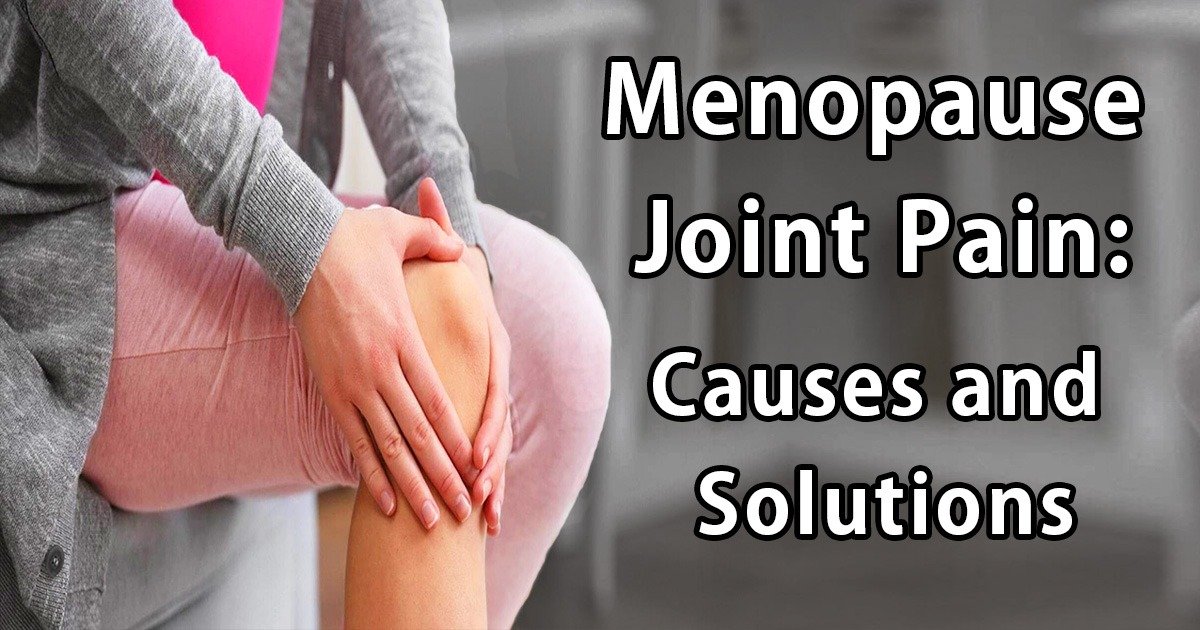Menopause joint pain can make your body feel sore, stiff, or tired. It happens to many women as they grow older and their hormones change. This kind of pain is not just from getting older — it’s often because the body makes less estrogen during menopause. In this guide, we will talk about why this happens, how to feel better, and new ways to treat the pain. You will learn about healthy food, simple exercises, new tools, and when to talk to a doctor. With the right help, you can feel strong and stay active during menopause.
Understanding Menopause and Its Symptoms
Menopause is a normal time in a woman’s life. It usually happens when she is in her 40s or 50s. During menopause, a woman’s body stops having monthly periods, and she can no longer have babies. This happens because her body makes less of a hormone called estrogen.
When estrogen levels go down, women may feel some changes in their body. These are called menopause symptoms. Some women get hot flashes — a sudden feeling of heat in the face, neck, or chest. This can make them sweat or feel uncomfortable. If this happens during the night, it’s called a night sweat, and it can make it hard to sleep.
Many women also feel more emotional than usual. They might feel sad, angry, or moody for no clear reason. This is called a mood swing.
Another common change is vaginal dryness. This can make the private area feel sore or itchy. It may also make it hurt during close contact or cause infections.
All these changes happen because of low estrogen. It can affect many parts of the body. Learning about these signs can help women understand what’s happening and find ways to feel better during this time.
The Link Between Menopause and Joint Pain
When a woman goes through menopause, her body makes less of a hormone called estrogen. This change can cause many symptoms — and one of them is joint pain.
Estrogen doesn’t just help with periods and having babies — it also helps your joints stay healthy. It keeps them smooth, helps fight swelling, and makes sure they move easily. When estrogen drops during menopause, the joints can start to feel stiff, sore, or swollen.
This joint pain is not just because someone is getting older. It’s mostly because of the hormone changes in the body. That’s why some women suddenly feel more pain in their knees, hands, or hips during this time.
It’s also easy to confuse menopause joint pain with arthritis, because both can make your joints hurt. But arthritis is a different problem. Menopause joint pain comes from low estrogen, not from joint damage.
Knowing that joint pain is linked to menopause can help women find the right ways to feel better. Gentle exercise, healthy food, or hormone treatments may help. Understanding the cause is the first step to getting relief and feeling more like yourself again.
Identifying Joint Pain Related to Menopause
When you are going through menopause, you might wonder why your joints hurt. Sometimes your knees, hips, or hands might feel stiff, swollen, or not move as well as before. This can be because of menopause.
It’s easy to think your joint pain is from something else, like arthritis, but menopause joint pain is a little different. One way to tell is by when the pain started. If it began around the same time you had other menopause signs — like hot flashes or trouble sleeping — then it might be from menopause too.
Also, menopause joint pain usually feels worse in the morning or after you have been sitting still for a while. But as you move around, the pain might get a little better. That’s different from other joint problems that don’t improve with movement.
By paying attention to these clues, you and your doctor can find the best way to help your joints feel better. Knowing your joint pain is linked to menopause is the first step to feeling relief and taking care of your body during this time.
Natural Ways to Help Menopause Joint Pain
There are simple and natural things you can do to help with joint pain during menopause.
First, moving your body every day is very good. Walking, swimming, or doing gentle stretches like yoga can make your joints feel less stiff and sore. These activities help your joints stay flexible and strong.
Next, what you eat matters a lot. Some foods can help fight swelling and pain in your joints. Try to eat lots of colorful fruits and vegetables every day. Foods like salmon, walnuts, and chia seeds have healthy fats called omega-3 that help reduce joint pain.
Keeping a healthy weight is also important. If you carry extra weight, it can put more pressure on your knees, hips, and ankles, making pain worse. Eating well and staying active can help you keep a healthy weight and feel better.
Finally, drinking plenty of water is very helpful. Water keeps your joints wet and smooth inside, so they move easier and hurt less.
By doing these natural things—moving, eating healthy, keeping a good weight, and drinking water—you can help your joints feel better and enjoy life more during menopause.
The Role of Gut Health in Menopause Joint Pain
Did you know that your gut can affect how your joints feel? New research shows that gut health plays a big role in menopause joint pain. The gut is where many hormones are processed, including estrogen. When your gut is healthy, your body handles hormones better, which may help reduce joint pain.
A healthy gut also helps lower inflammation. Inflammation is one of the main reasons joints feel sore and stiff. If your gut isn’t working well, bad bacteria can grow, and this can lead to more swelling and pain in the joints.
To keep your gut happy, eat foods that are good for it. Yogurt, kefir, bananas, and foods with fiber help grow the good bacteria in your stomach. Drinking plenty of water also helps your digestive system work smoothly.
If you want extra help, talk to your doctor about probiotics. These are tiny good bacteria that come in pills or powders. They can support your gut and may help reduce menopause joint pain.
Latest Hormone Therapy Options for Joint Relief
Sometimes, lifestyle changes aren’t enough, and hormone therapy may help. During menopause, your estrogen levels drop, and that can cause joint pain. Hormone therapy brings those levels back up and may make your joints feel better.
Today, there are newer and safer hormone therapy options. Some are called bioidentical hormones, which are made to be very similar to the ones your body makes. Others come in patches, creams, or pills. Doctors may also use low-dose estrogen just in certain parts of the body, like the skin or vagina, to avoid side effects.
These new options may help ease joint pain without strong medicines. They can also improve sleep and mood. Always talk to your doctor first to see if hormone therapy is safe for you.
Remember, this treatment may not be for everyone, but it’s good to know what choices you have. The right treatment can help you move and feel better during menopause.
When to Seek Professional Help for Menopause Joint Pain
Menopause joint pain can be hard to deal with. Sometimes, natural ways like exercise and healthy food help a lot. But if the pain doesn’t go away, gets worse, or makes it hard for you to sleep or move, it’s important to see a doctor.
A doctor will ask you about your pain and how it feels. They may do tests to make sure nothing else is causing the pain. This helps them find the best treatment for you.
Doctors can give medicine to help with hormones or reduce swelling. Sometimes, they suggest special exercises to make your muscles stronger and protect your joints.
Your doctor might also tell you to make other changes to your daily routine to help with the pain. These changes are made just for you, based on how bad the pain is and your health.
Remember, you don’t have to live with strong joint pain during menopause. Talking to a doctor can help you find ways to feel better and enjoy life more. Asking for help is a smart and brave step to take care of yourself.
Tech-Based Pain Relief Tools (2025 Update)
Technology can now help with menopause joint pain too! There are cool new tools that are safe and easy to use at home.
For example, heated knee or back braces can warm up your joints and ease pain. These braces plug into a charger or use batteries and can feel very soothing. You can wear them while sitting or resting.
Massage guns are another helpful tool. They gently tap your muscles and joints to help them relax. Many women use them to reduce stiffness and feel better after a long day.
There are also phone apps that help you track your pain. These apps show when your pain is worse and what makes it better. You can share this with your doctor to get better care.
All of these tech tools are simple and don’t need a lot of training. If natural methods aren’t enough, using helpful gadgets can make a big difference in how you feel every day.
Conclusion
Menopause joint pain can be hard, but you don’t have to suffer alone. There are many ways to feel better. You can eat healthy food, move your body, try new tools, and talk to your doctor. Your joints can feel better with the right care. Remember, this is a normal part of life, and many women go through it. The good news is, you can manage the pain and enjoy your days again. Keep learning, stay active, and take care of yourself — you are not alone on this journey.
FAQs About Menopause Joint Pain
Q1: What is menopause joint pain?
A: Menopause joint pain is when your joints feel sore, stiff, or swollen during menopause. It happens because your body has less estrogen, a hormone that helps keep your joints healthy.
Q2: Which joints hurt the most during menopause?
A: The most common areas are the knees, hands, hips, and shoulders. These joints may feel tight or hurt more in the morning or after sitting too long.
Q3: Can menopause joint pain go away?
A: Yes, for some women, it gets better with time or treatment. Eating healthy, exercising, and talking to a doctor can help manage the pain.
Q4: Is this the same as arthritis?
A: No, menopause joint pain is caused by hormone changes. Arthritis is a disease that affects the joints differently, though the pain can feel similar.
Q5: What is the best way to treat menopause joint pain?
A: The best way is a mix of things—gentle exercise, a good diet, staying at a healthy weight, and using tools or medicine your doctor suggests.

I’m Emma Rose, the founder of tryhardguides.co.uk, and a content creator with a passion for writing across multiple niches—including health, lifestyle, tech, career, and personal development. I love turning complex ideas into relatable, easy-to-digest content that helps people learn, grow, and stay inspired. Whether I’m sharing practical tips or diving into thought-provoking topics, my goal is always to add real value and connect with readers on a deeper level.
Discover more from Try Hard Guides
Subscribe to get the latest posts sent to your email.

